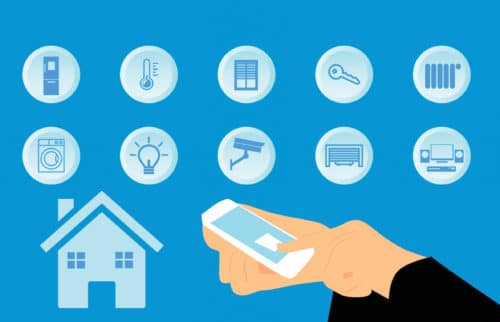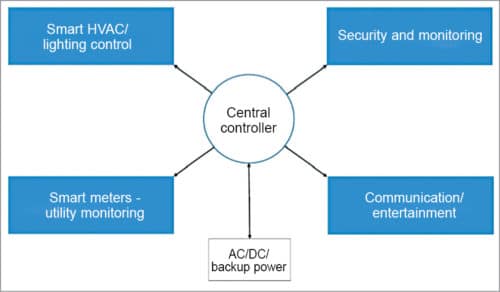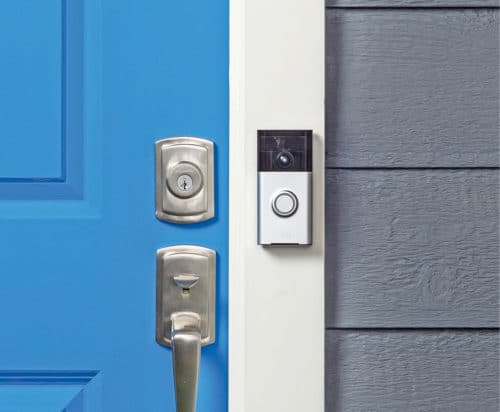Security and monitoring in the field of home automation continue to evolve. New electronic designs and solutions continue to accelerate this trend. Now that many homes are automated, smart and connected, designers of electronics need to continue to offer improvements on issues related to power, sensing, command and control, and communications

My third daughter recently graduated from college with an art degree. I have had the opportunity to see her artwork displayed in areas made to resemble a museum. Besides the artwork on the wall, museums always make me think of security. If you are a fan of heist movies, you know that these always require that the thieves employ ingenious efforts to get in and snatch the priceless treasure. They must manoeuvre through all sorts of security, laser beams, motion detectors, pressure sensors and the like. How awesome would it be if our homes had the same technical advantages?
Home automation has evolved into the connected home, which is a broad system of home electronics that has so much intelligence it can quickly repay owners for upfront investment costs through efficiency savings and in a relatively short amount of time. The connected home promises to bring further automation into the home, linking together disparate technologies, appliances and devices, and coordinating them into a synergistic platform to serve homeowners, all within the control of their fingertips. As a simple and fully integrated system, home automation offers home occupants peace of mind, which in today’s chaotic and turbulent world is of enormous economic value.
One aspect of home automation that helps drive peace of mind involves home security and monitoring. This article articulates how leading-edge innovation and electronic component technologies are supporting advanced smart home security and monitoring solutions. These advances stem from new developments in electronics, technology and design areas involving power, sensing, compute, command and control, and communications. Home automation is conveniently remaking the home environment, making it safer and more secure.
Security and monitoring
Consider for yourself a home automation system that could provide security and monitoring along with a wide variety of entertainment options. This home would incorporate infrastructure that can transmit and receive secure high-speed internal and external communication. It would do so in a manner that both optimises and minimises home resource consumption of utilities such as power, water, gas and data. This automated home would have the intelligence to allow it to act as its own steward over low-end tasks within the home, operating in a manner analogous to a well-intentioned house sitter. This type of automated house would be both smart and connected.
Today’s electronic components have become ever more affordable while simultaneously increasing exponentially in performance capabilities. Today’s communication infrastructures and services have become wonderfully standardised, convenient and ubiquitous. Integration of both passive and active semiconductors to produce these complex infrastructures has brought forth a network so powerful that it equates to a personal, 24/7, around-the-clock, electronic butler in your home, on your property.
Automated homes consist of multiple separate systems that one integrates to work together. In its simplest form, one might envision an entire network as connecting in a manner as shown in the illustration in Fig. 1.

Since our focus is on security and monitoring, we will forego further discussion on the three other blue blocks in Fig. 1. Three areas that we will not discuss in this article are:
- Smart heating, ventilation and air-conditioning (HVAC), and smart lighting control
- Smart meters for utility monitoring
- Communication and entertainment
Before the development of the smart home, false alarms of intruder detection could account for up to 98 per cent of security triggers. This high level of false positives is expensive and ends up producing a syndrome analogous to the Aesop’s Fables classic, The Boy Who Cried Wolf.
Smart sensors now have wireless capabilities, allowing for their optimal placement around the home. Many smart sensors have the requisite intelligence to ascertain what a true positive-alarm trigger condition is, thus avoiding false positives. Programming options through improved command and control products, like microprocessors, allow for custom tailoring of sensors, especially for such specifications as sensitivity and multiple confirmation triggers that assist with improving accuracy in identifying a legitimate alarm trigger.
Occupant health monitoring is an expanding area of development with the creation of powerful accelerometer monitors and motion/temperature sensors. Sensors have expanded to include monitoring water leaks, carbon-dioxide and carbon-monoxide buildup, and other volatile organic compounds (VOCs). Likewise, other important items that concentrate on the health and efficiency of systems such as HVAC performance relative to specifications undergo monitoring as well.
Power
Turning our attention to the four key technology-related design considerations of power, sensing, command and control, and communications, which enable home automation security and monitoring, we will start by examining how power management technology advancements are assisting in this effort.
Power management is a key design challenge in every Internet of Things (IoT) and home automation security product. The ability to answer high peak current demands and very lengthy, low-power system standby times requires solutions that extend battery life. Electronic components manufacturers focus on offering a wide variety of products in which electrical energy gets efficient utilisation and distribution where it is essential.
Non-isolated direct current to direct current (DC/DC) and point-of-load (POL) power supplies function in security and monitoring applications. On input side, power may come in via wired-power options, often through 12V DC or using a battery-powered option, with the possible inclusion of supercapacitors—a type of high-capacity capacitor—or often in the form of electric double-layer capacitors (EDLCs).
DC/DC power converters that adjust input voltage to what the system needs to output are often in operation. Designers working on such power converters may consider high-quality, synchronous buck converters, as these are compact and easy to use. These parts may provide ample efficiency advantages over low-dropout (LDO) regulators.
When home automation systems utilise battery-powered devices, often designers employ step-down converters. These parts assist with battery-based applications, as these are capable of drawing very low quiescent currents (IQs), guaranteeing that the parts will draw low currents from the battery when in a wait state.
Capacitors are key components for efficient power conversion. One common thread among high-efficiency switch-mode power supply, microprocessor and digital circuit applications is the need to reduce noise while operating at higher frequencies. Specifically valuable for filtering, tantalum capacitor technology has many of the ideal characteristics that DC/DC converters, power supplies and other applications require. In home automation applications, power supply capacitors should exhibit many of the following positive characteristics:
- High capacitance retention at high frequencies
- Low failure rate
- Wide voltage range
- Surge robustness
- Environment (moisture/temperature) resistance
- Low cost
Power designs require protection against transient voltages. Using a capacitor is a common technique to control transients and protect the circuit in voltage control designs. A capacitor may operate across the line/pin to integrate the voltage and assist in the prevention of electrostatic discharge (ESD) damage. Engineers often over-estimate the performance of a standard multilayer ceramic capacitor (MLCC) because of the capacitor’s significant value drop upon an applied ESD event. Introduction of supercapacitors, in the place of MLCCs, will actually make a design more robust.
Sensing
Electronic systems allow security and monitoring systems to respond in changing situations, conditions and contexts. Sensors may signal door and window motions, smoke or carbon-monoxide presence, physical disturbances, pressure changes and more. These connected sensors offer a wide range of uses in smart home security and automation applications. Whether through specific sensor components and related op-amps employed to enable battery-powered wireless devices or through ESD protection for high-speed signal lines, engineers require a range of products to safeguard their designs.
Now, let us examine how sensor components and related solutions lead to excellent security monitoring design.
Sensor devices provide real-time system protection, feedback control and high accuracy system monitoring. Position sensors enable engineers to determine absolute and relative positions, including angle, presence, proximity, distance, flow, level and velocity. Such sensors as light, image and analogue front-end (AFE) help designers capture a broad range of wavelengths.
Because your human eyes cannot be everywhere, it is helpful to have another set of eyes on your home to establish extra protection. One option a designer might consider employing is an ambient light sensor. An ambient light sensor measures the intensity of visible light. Spectral response of the sensor tightly matches the photopic response of the human eye and includes significant infrared (IR) rejection (Fig. 2).

Still, looking for home intruders is not the only required sensing function in many security monitoring systems. Often a change in the ambient environment warrants monitoring. A change in humidity may indicate that an environmental shift is in process that may cause significant damage to valuables within a monitored location. In such a situation, a humidity sensor may do the job. It can provide excellent measurement accuracy at very low power levels and may also include an integrated temperature sensor.
In isolation, sensors alone may not be able to complete the job. Often, these need a signal boost using amplifiers so that downstream electronics can further manipulate and evaluate their electronic information. Ultra-low-power, operational amplifiers find employment in sensing applications with battery-powered, wireless and low-power wired equipment. Such ultra-low-power, operational amplifiers help reduce power consumption in equipment like carbon-monoxide detectors, smoke detectors and passive infrared (PIR) motion detectors where operational battery-life is critical.
Command and control
At the core of any home automation security and monitoring application, there is a need to have command and control over electronic signals. A proper command and control system allows for the achievement of greater energy and operational efficiency in the system. By incorporating products and technology with the brains to better monitor and regulate systems, including lighting, windows and doors, video cameras and more, a home becomes more safe and secure for its occupants.
An effective way to utilise the command and control function is to use a controller, specifically a microcontroller unit (MCU). MCUs are useful in embedded devices, as these contain the processor, memory and peripherals in one integrated unit. Many of today’s MCUs may excel at ultra-low-power sensing and measuring. These allow designers to use a command and control platform from which to coordinate their design requirements. Since they possess internal memory, both random access memory (RAM) and read-only memory (ROM), MCUs are well-positioned to deliver fast, flexible and reliable command and control functions without requiring additional off-chip capabilities. Onboard memory and peripherals help MCUs minimise their total power consumption.
Communications
Home automation security and monitoring applications, of which the increasing need for wireless connectivity to accommodate the IoT is driving, require a new dimension of wireless connectivity security. Upon proper authorisation, only where appropriate, data must undergo proper protection by allowing proper send and receive transmissions.
In home automation security and monitoring designs, wireless MCUs, which fully support Bluetooth, Zigbee, low-power wireless personal-area networks (LoWPAN), Thread, Wi-Fi, sub-1GHz, Sigfox or other protocols must by design provide highly-secure, cloud-ready solutions for IoT accessibility. Additionally, wireless MCUs require an input voltage filtering/decoupling network and an output impedance matching network for the radio frequency (RF) antenna.
Today, wireless MCUs can offer designers access to distinct wireless protocol modes. These may offer a blend of long/robust range, low power and high data rates. By design, these often consume very low amounts of power, allowing for battery operation. These may come with sensors that help them recognise when these should be active and communicating, or when these should be in sleep or wait state.
Wireless MCUs give engineers greater flexibility, as the designers may consolidate the command and control function with communication function ultimately to offer high levels of integration. Such levels of integration will simplify designs and ensure continuously reliable communication.
Conclusion
Security and monitoring in the field of home automation continue to evolve. New electronic designs and solutions continue to accelerate this trend. Now that many homes are automated, smart and connected, electronic designers need to continue to offer improvements on issues related to power, sensing, command and control, and communications. A design engineer’s imagination is never automated. Consider how your imagination may take hold of the future, and continue to make your future and your homes more convenient, secure and safe.
Paul Golata is senior technical content specialist – marketing, Mouser Electronics






